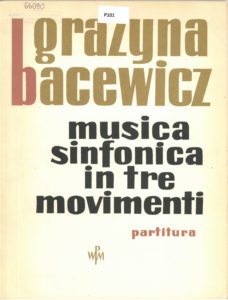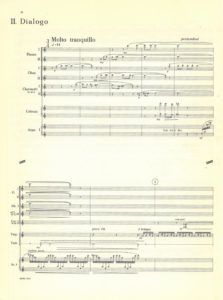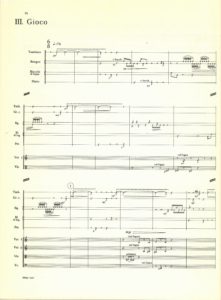Musica sinfonica in tre movimenti was written at a time when Witold Lutosławski began working on his Symphony No. 2. Obviously Grażyna Bacewicz could not have predicted the results of her colleague’s work, but she must have known Lutosławski’s String Quartet, which consists of an introductory part and the main part. We do not know whether, following this model, Bacewicz decided to discard the corset of the traditional four-movement symphonic cycle; the fact is, however, that her three-movement work, which bears the neutral title of Music, does have a unique form. The titles of the movements – Tesi, Dialogo, Gioco – suggest a certain programme idea. The first, shortest, movement formulates some theses which are subsequently developed in dialogues and resolved in the final Gioco. The sound language of the piece is more radical than in the Concerto for Large Symphony Orchestra composed three years earlier. The motivic work is replaced by a “melody of sound colours”, while old arrangements in the form of, for example, interval scales, appear as quotations. However, it is possible to speak of some phases of the work as more or less self-contained wholes, differing in their kinds of movement, texture and mood. The predominant colours are dark and glassy; they lack a euphonic warmth and create an atmosphere of tension resulting from a narrative without longer phrases or mutual relations between successive sequences.
We are introduced to the climate of the piece by the very beginning of Tesi with its sharp, dense brass chord followed by a series of short motifs in the woodwind, melodic percussion (xylophone, vibraphone, celesta) and strings counterpointed by the timpani, and the whole picture is completed by a sharp piano glissando sealed in the woodwind by fragments of a scale built of descending seconds and a motif created by the strings, the brass and the woodwind, and ending with a slapstick stroke. In the following sequence we hear, against a background of monorhythmic runs based on progressively moving motifs – an effect known from the composer’s many other pieces – a loud voice of two trombones, as if in a transformed motif from Wagner’s Götterdämmerung! The dialogue of the trombones and other instruments becomes increasingly dense until another culmination in the form of fast glissandos of the xylophone, celesta, harp and strings. The strings now take on the role of the main voice – first in a mournful phrase growing from a minor key, followed by a reminiscence of a transformed introduction to Music for Strings, Trumpet and Percussion, and then short, broken motifs (come percussione, saltando, gettate) and passages – bringing about, with the other instruments, a pulsating cluster and a sharp (ff) final chord.
The title Dialogo of the second movement (Molto tranquillo) can be misleading. The only common thread in this part is a motif built of two seconds: ascending major second and descending minor second as well as an inversion of this motif. Yet despite developments and transformations of the figure in the following sequences, there is no real dialogue, no mutual relation building the structure and dramaturgy of the form. Successive groups of instruments speak with their own voice, they break off their lines as if not expecting an answer. The initial, real dialogue of the woodwind instruments is replaced, like a memento, with an ostinato of the timpani and octaves of low horns spread against this background. The timpani with their relentless ostinato will return again, creating – sometimes with a percussive piano – an atmosphere of sadness, horror even, especially when tension clearly grows. An important role is played by instruments to which short solo fragments are entrusted towards the end. Two trumpets with a jazz mute bring back the main version in an imitation as well as an inversion of the main motif, holding this dialogue against a background of a timpani, harp and cello ostinato. Two solo violins close Dialogo with a transformed formula of the main motif, presenting it against a fading harp ostinato. Thus ends this slow, nostalgic, not to say dark, part of the piece, so different from Bacewicz’s many other works, full of energy.
This impression does not change much in the final Gioco, intended as a part lightening the mood. Although there are sound gags in the form of “crazy” glissandos played by the piano or other instruments, or “leaping”, arrhythmically repeated chords, this movement is a return, as it were, from a dark dream to a known world – overlapping short passages, progressively shifting motifs and motivic correspondence between the various instrument groups, which gives the whole dramatic consistency. It is hard to resist the impression that there is something else hidden under the instrumental virtuosity, something contradicting the composer’s theory of complete autonomy of music.
Musica sinfonica in tre movimenti was premiered on 6 September 1965 in Stockholm by the Warsaw Philharmonic Orchestra conducted by Witold Rowicki.
- Musica sinfonica in tre movimenti, PWM score, cover
- Musica sinfonica in tre movimenti, PWM score, mov. 1
- Musica sinfonica in tre movimenti, PWM score, mov. 2
- Musica sinfonica in tre movimenti, PWM score, mov. 3



